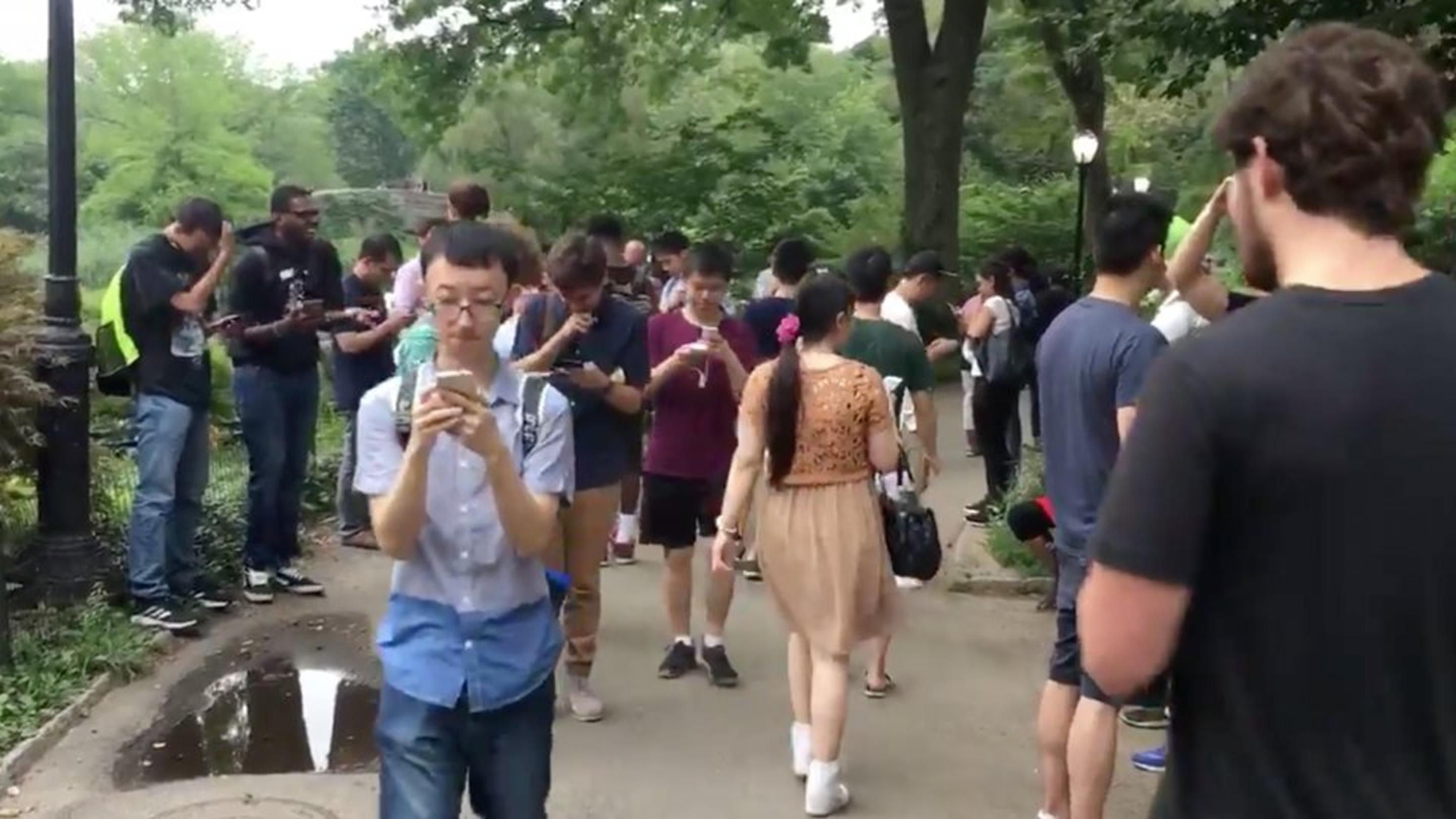在全球掀起一股狂潮的Pokémon Go,儘管目前在台灣還沒有開放玩家下載,但你知道這有史以來最熱門的遊戲,幕後的推手是誰嗎?他是如何實踐自己的夢想,讓人們在大街上瘋狂地追逐這些可愛的小怪獸們?
他將地球放入你的口袋中,而現在,他將口袋怪獸們釋放到地球上了。
John Hanke, 加州柏克萊大學96年MBA畢業生以及Niantic Labs公司的CEO,正是推動Pokémon Go – 這個有史以來對智慧型手機帶來最猛烈的狂熱 - 背後的原動力。自從7月6日產品上市,在短短一週內,這個擴增實境遊戲已經讓上百萬攜帶著手機的玩家上街,在定位系統協助之下去追捕那些日本動畫角色。湧入下載的數量近乎讓Niantic的伺服器當機,且活躍用戶的數量幾乎與推特人數相同。

(圖為紐約中央公園內,充滿著追尋Pocket Monsters的玩家)
這呈現了新科技所帶來的現象之一,就像本週紐約時報報導的:當一種新科技 - 例如Pokémon Go這個case,利用擴增實境或簡稱AR,融合數位科技與真實世界 - 將那些搶先擁有的人手上的小玩具突破為某種更大的東西。
然而,這並非Hanke第一次將一項突破性的技術推動成為主流。當他在90年代中期還是個Haas MBA學生時,他就與人共同創立一間公司研發了第一批線上遊戲之一,讓數百人在虛擬環境中一起參與遊戲。
Hanke接著與人共同創立了Keyhole,銜接了高階電腦上的地理空間資料視覺化與我們都會攜帶在口袋中的導航應用程式之間的差距。Google在2004年以3千5百萬美元收購了Keyhole,Hanke留下來領導著Google地球、地圖以及街景服務的發展。接著他還在Google內部創立了Niantic Lab來專注於研發新一代遊戲,並且在去年將它分割為另一間公司。
達成願景
“John展現出許多企業家精神最好的特質以及Berkeley-Haas精神:透過不停地創新展現出領導力,不帶任何姿態或虛張聲勢,為整個社會以及所有與他合作的人創造許多價值。”Jerome Engel如是說,他是Lester Center for Entrepreneurship的創立執行長,近來寫了一份商業案例探討關於Hanke脫離Google的決定。(Hanke上個月突然造訪Engel的高階主管課程,正好在此案例開始討論時)
Pokémon Go的成功,對Hanke來說,是實現他當初前往Haas所要達成的願景。
“我當初寫給Haas的申論題是有關於在互動式遊戲與科技之空間的機會” Hanke在2014年Haas的影片中說道,”我想要建立能夠加深人們對於他們城鎮或社區參與的應用程式,以鼓勵人們能夠確實在真實世界相遇。”
數位化增強社會互動
Niantic Labs的第一款擴增實境遊戲是以科幻為基礎的Ingress,像Pokémon Go一樣,充分利用每隻智慧型手機上的攝影與GPS功能。玩家必須造訪具有文化意義的地方,例如雕像或歷史建築,才能夠開啟虛擬”能量塔”並且佔領領土。然而真正神奇的是 - 也是Hanke開發遊戲的動機 - 在離線時所發生的事。
“它給予人們一個藉口去遇見其他真實的人。看著這些人聚在一起,看著人們從活動中、探索城市中、交到新朋友時所得到的開心與喜悅對我來說是難以置信的報酬。”Hanke在視訊訪談中提到Ingress時這麼說著。
數位化增強社會互動的概念已經與這個新遊戲一起迅速擴大:從7月12日開始,超過5000人已經答應出席Facebook的邀約,參與7月20日在舊金山所舉辦的” Pokémon Go Crawl”,還有2萬2千人表示”有興趣”參加。
Pokémon Go透過這些可愛的動畫主角帶來了擴增實境的主流 - Pokémon稱他們為”口袋怪獸” - 深受那些1990年代玩過電玩與交換卡片而如今已成長為大人們的喜愛。Niantic與擁有部分Pokémon經銷權以及Pokémon股份有限公司的任天堂共同研發這款遊戲。
Hanke讚揚Berkeley-Haas幫助他培養的不只有技能,還有成為一名專業企業家的心態。
(John Hanke專訪影片)
P.S. Pokémon Go(寶可夢)台灣已於8/6正式開放下載,亞洲限定版的大蔥鴨你蒐集了嗎? ><
本文由UC Berkeley Laura Counts在Jul. 14, 2016發表於UC官方網站
文章來源:
http://universityofcalifornia.edu/news/man-behind-pok-mon-go
其他參考資料:
以下為原文:
The man behind Pokémon Go
He put the earth in your pocket, and now he’s unleashed pocket monsters on the earth.
John Hanke, UC Berkeley MBA '96 and CEO of Niantic Labs, is the driving force behind Pokémon Go, the hottest craze to hit smartphones—ever. Since its release just a week ago, the “augmented reality” game has sent millions of phone-toting players to the streets on the hunt for animated Japanese characters that pop up with the help of location services. The crush of downloads nearly crashed Niantic’s servers, and the number of active users is nearly on par with Twitter.
It’s one of those moments, The New York Times declared this week, “when a new technology—in this case, augmented reality or A.R., which fuses technology with the physical world—breaks through from a niche toy for early adopters to something much bigger.”
Yet it’s not the first time Hanke has propelled a breakthrough technology into the mainstream. As an MBA student at Haas in the mid-1990s, he co-founded a company that developed one of the first online games to allow hundreds of people to play together in a virtual environment.
Hanke went on to co-found Keyhole, which bridged the gap between geospatial data visualization on high-end computers and the navigation apps we all carry in our pockets. Google acquired Keyhole in for $35 million 2004, and Hanke stayed on to lead the development of Google Earth, Maps, and StreetView. He then launched Niantic Labs inside Google to focus on next-gen games, and spun it out as a separate company last year.
Achieving a vision
"John represents many of the best attributes of entrepreneurship and Berkeley-Haas: Leadership through continuous cycles of innovation, without attitude or bravado, creating value for society and all who collaborate with him," said Jerome Engel, founding executive director of the Lester Center for Entrepreneurship, who recently wrote a business case that explored Hanke’s decision to separate from Google. (Hanke made a surprise visit to Engel's executive education class last month for the debut of the case.)
The success of Pokémon go is, for Hanke, a realization of the vision he came to Haas to achieve.
“My essay to Haas was written about the opportunity in the space of interactive gaming and technology,” Hanke said in 2014 Haas video. “I wanted to build applications that would deepen people’s involvement in their town or community, to encourage people to actually meet up in the real world.”
Digitally enhanced social interaction
Niantic Labs’ first augmented reality game was sci-fi based Ingress, which—like Pokémon Go—takes advantage of the cameras and GPS on every smartphone. Gamers must visit places of cultural significance, such as statues or historic buildings, to open virtual “portals” and capture territory. Yet the real magic—and Hanke’s motivation in developing the games—is in what happens offline.
"It gives people an excuse to meet other real people. It's incredibly rewarding for me to see these people coming together and to see the happiness, the joy that people are getting from exercising, exploring their city, and making new friends," Hanke said in the video interview, referring to Ingress.
The concept of digitally enhanced social interaction has exploded with the new game: As of July 12, more than 5,000 people had RSVP'ed to the Facebook invite for a "Pokémon Go Crawl" in San Francisco on July 20, with 22,000 more responding as "interested."
Pokémon Go brought A.R. mainstream through the appeal of cute animated characters—Pokémon translates as “pocket monster”—beloved by those who came of age playing the video games and trading cards in the late 1990s. Niantic developed the game in conjunction with Nintendo, which partially owns the Pokémon franchise, and Pokémon Co.
Hanke credits Berkeley-Haas for helping him cultivate not only the skills, but also the mindset to become a professional entrepreneur.






